1
Mississippi Woollen MillsCirca 1880-1900
Appleton, Town of Mississippi Mills, Ontario, Canada
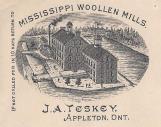 Credits:
Credits:North Lanark Regional Museum (2012.55.145.5)
Donated by Sheila Babb and Ann E. Love
2
By the early 1990s all of Appleton's mills had closed. The sawmill and gristmill had disappeared by the early 20th century while the woollen mill was last to close in 1992. Originally the mills were a driving force in the development of the village. The gristmill and sawmill provided food, building materials, and employment for the local residents. The population grew around the mills adding a blacksmiths shop, a general store, a cobbler and many more small businesses.With the woollen mill the economy grew even stronger. Two churches, a school, a community hall and several more businesses were built to support the local residents.
Although the mills have faded away, their legacy and heritage are still alive in Appleton. A tour through the streets of Appleton shows the amazing houses, buildings, and ruins all interconnected and all stemming from the original Mills of Appleton.
3
Map of the Appleton Community 1930-1940, Drawn from Memory1930-1940
Appleton, Town of Mississippi Mills, Ontario, Canada
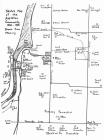 Credits:
Credits:North Lanark Regional Museum (Library)
A History of the Appleton School, S.S. No. 11 Ramsay, edited by Blanche James Dezell & Eleanor Command Wright (p.23)
4
The Ruins of the Appleton Woollen MillPre-2004
Appleton, Town of Mississippi Mills, Ontario, Canada
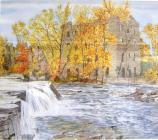 Credits:
Credits:North Lanark Regional Museum
Donated by Hank Collie
5
The crumbling ruins of the original Mississippi Woollen Mills built by Robert Teskey and his son John Adam remain as reminder of Appleton's textile history.After the fire of 1950, the mill ruins stood several metres high right up until the early 21st century when the ruins were knocked down to a much shorter and less majestic height. The ruins were officially knocked down for "safety" reasons, although prior to this community members from Appleton and the wider Town of Mississippi Mills lobbied for the mill ruins to be preserved & safely reinforced as a heritage site.
6
Members of Collie family standing in front of the ruins of the Woollen Mill in 19841984
Appleton, Town of Mississippi Mills, Ontario, Canada
 Credits:
Credits:North Lanark Regional Museum (2012.49.6.2)
Donated by Isobel (Meabry) Collie in memory of her husband, John D (Jack) Collie, and his family
7
Appleton Woollen Mill Ruins, 2003 (Photo by Don & Fran Cooper)1 June 2003
Appleton, Town of Mississippi Mills, Ontario, Canada
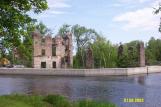 Credits:
Credits:North Lanark Regional Museum 2013.4.3
Photographer: Don & Fran Cooper
Donated by Don & Fran Cooper
8
Appleton Woollen Ruins, 2004 (Photo by Bernice Butler)2004
Appleton, Town of Mississippi Mills, Ontario, Canada
 Credits:
Credits:North Lanark Regional Museum (2013.7.1)
Photographer: Bernice Butler
Donated by Bob & Bernice Butler
9
Former Collie Woollen Mill Office Building, derelict. Photo by Alison BallCirca 2006
Appleton, Town of Mississippi Mills, Ontario, Canada
 Credits:
Credits:Courtesy of Alison Ball (https://sites.google.com/site/unravelledexhibit/home)
Photographer: Alison Ball
10
In addition to the stone ruins, Appleton once had a cement block factory built in 1940 by the Collie family as part of their woollen mill. This building sat deserted after the mill shut down in 1992 and finally met its end on February 2, 2007 when an arson set fire to the building - destroying the building and the equipment stored inside.It was a sad fate for the industrial building and brought to the forefront several environmental issues. The 45 acres site currently sits vacant, waiting for its next step in life.
11
Site of the Collie Woollen Mill built in 1940, destroyed by fire in 200713 November 2012
Appleton, Town of Mississippi Mills, Ontario, Canada
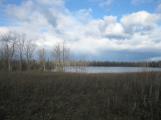 Credits:
Credits:North Lanark Regional Museum (2012.91.14)
Photographer: Sarah Bennett
12
Appleton is now a quiet village for those looking to escape from the bustling City of Ottawa. The Mississippi River winds through the community providing a sense of calm and serenity. The banks of the river play host to the community's main businesses: tourist, commercial and agricultural. The Mississippi River Golf Club, Saje Wisdom and the North Lanark Regional Museum attract crowds of locals and tourists looking for a relaxing day. The gravel company Al-Car Sand & Gravel and many farms represent the commercial and agricultural side of Appleton.Looking closely, one can see the history of Appleton come to life through the historic houses, sites and ruins that dot the community.
13
Appleton wasn't always called Appleton. Originally the area was named Apple Tree Falls in honor of the apple trees growing along the banks of the river. When the Teskey family arrived and built their mills, the area soon became known as Teskeyville. It wasn't until 1857 when the Post Office came to the village that the name Appleton was chosen.Apple trees have remained an important part of the community. In 2012 the community planted several apple trees across the village:
"These fruit trees have been planted courtesy of the Edible Tree Program of the Mill's Neighbourhood Tomato Community Garden Project through a generous donation from Tree Canada and their sponsors, Taste of Nature and Loblaw Companies Limited. Many thanks to the community volunteers who have planted and are caring for these trees."
14
Fruit Tree planted on East side of Mississippi River in Appleton13 November 2012
Appleton, Town of Mississippi Mills, Ontario, Canada
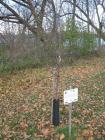 Credits:
Credits:North Lanark Regional Museum (2012.91.86)
Photographer: Sarah Bennett